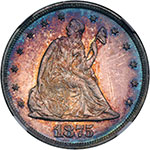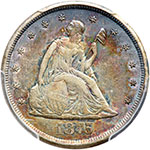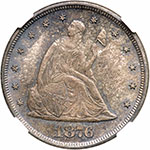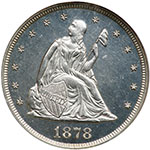
|
Sale 81
The Pre-Long Beach Sale
| Lot |
Photo |
Description |
Realized |
Lot 792 |
 |
1875. NGC graded Proof 67 Cameo. Wonderful iridescent blue and magenta-purple toning on both sides. Only 2,790 struck. Silver mirror luster rolls with watery purity from the surfaces of this majestic Proof. The surface is immaculate. A great deal of discussion also surrounds a coin's strike. This has excellent detail with full bold devices including Liberty and eagle, stars, date and legend.
The first of only four proof Twenty-Cent issues, the 1875 has an original mintage of 2,790 pieces. Survivors of this delivery are seen with a bit more frequency in today's market than those of the other Proof deliveries in this series but virtually never in this sharp condition. This 1875 issue is popular coins among first-year Type collectors who specialize in specimen coinage.
The abortive Twenty-Cent piece was produced in Proof format in only four years from 1875-1878. Two of the deliveries (1877 and 1878) are Proof-only issues, and all four have long been popular among collectors, with modern investors seeking a high-grade representative of this curious denomination too.
If any lingering doubt remains in collectors� minds as to which coin is going to be boss in a rare coin portfolio, then it is this 1875 Proof 67 Twenty-cent Piece, a coin sure to run the show! Pop 4; 2 finer in 67 Star.
Estimated Value $23,000 - 24,000.
View details and enlarged photos
| Unsold |
Lot 793 |
 |
1875-CC. PCGS graded AU-50. CAC Approved. PQ. Nice old time rainbow toning on this still-lustrous example. One of only two dates in the series to bear the "CC" mintmark (PCGS # 5297) .
Estimated Value $1,000 - 1,100.
View details and enlarged photos
Check results on similar lots
| Realized
$1,175 |
Lot 794 |
 |
1876. PCGS graded Proof 65 Cameo. Blast white Gem Cameo Proof. Only 1,260 struck. The Twenty-cent piece, sometimes called a "double dime," had a brief appearance in the fourth quarter of the 19th century before its abrupt ushering off the stage of numismatic history. Primarily produced as an outlet for Nevada-mined Comstock silver, the 1876 was the second year of production and only two other years, 1877 and 1878, were struck in a limited production run as Proofs only. Briefly, the surfaces of this piece are gorgeous. They leave behind an impression of careful stewardship by its former owners: Both sides are brilliant; the fields show the expected reflectivity seen on Proofs, but what is important is the significant overlay of mint Cameo frost on the devices. This results in a two-tone contrast that grabs the attention of just about every rare coin connoisseur.
Historic Note: The Twenty-cent coin is one of several off-beat denominations produced by the United States Mint during the 19th century, and it also one of the briefest series in numismatics. In 1874, Senator John Percival Jones (R.-Nev) introduced a bill for coinage of this denomination. Jones' proposal may have been borne out of the realization that the lack of small change in the Western United States resulted in the public being short-changed whenever they purchased a ten-cent item using a Quarter. Minor coins (Cents and Nickels) would not be produced in any mint other than Philadelphia until the early 20th century, and the Half Dime was rapidly disappearing from circulation after its abolition under the Mint Act of February 12, 1873. While Jones' proposal may have been couched by him as altruistic, we suspect that a self-serving motive may have been to provide for the federal government to purchase silver at subsidized prices from western mine owners. Jones' home state was Nevada, after all. And the state was the site of the rich Comstock Lode with its campaign donors; even today, the state is known by the nickname of "The Silver State" and has a reputation for richly rewarding its well-heeled campaign donors.
Regardless of exactly what Jones' motivations were for proposing a Twenty-cent coin, the denomination proved a failure in commercial channels. Much like the 20th century Susan B. Anthony Dollar of 1979-99 was close in size to the Quarter Dollar, the Twenty-cent piece was easily mistaken for a Quarter as well, confusion that caused a great deal of negative feedback at the Mint. To aggravate this problem, the Twenty-cent piece bore a likeness that was too close to its cousin, the Seated Liberty Quarter. Pop 7; 14 finer, 1 in 65+, 11 in 66, 1 in 67. (PCGS # 85304) .
Estimated Value $9,000 - 9,500.
View details and enlarged photos
Check results on similar lots
| Unsold |
Lot 795 |
 |
1876. NGC graded MS-66. Only 14,640 minted. A needle sharp strike with remarkably clean surfaces. Lovely hues of violet and turquoise toning adds to its appeal. The 1875 Coinage Act that authorized this denomination consisted of four paragraphs. Section 1 stated that a silver coin of the twenty cent denomination would be struck from time to time and would weight five grams. Section 2 limited the legal tender status to five dollars in any single payment as with other minor coins, post-1873. Section 3 limited the legally tolerated deviation to one and a half grains, or two-hundredths of an ounce in one thousand pieces. Finally, section 4 simply stated that laws then currently in force would apply equally to the new 20-cent piece.
This coin was struck in the year of the Centennial Exhibition in Philadelphia's Fairmount Park, only a short distance from the Mint. Pop 16; 5 finer, 1 in 66 Star, 4 in 67.
Estimated Value $8,000 - 9,000.
View details and enlarged photos
| Unsold |
Lot 796 |
 |
1876. NGC graded Proof 64 Cameo. PQ. Lovely even blue shade. An incandescent and sparkling toned coin and one whose originality, whose beauty comes with fully defined design features. We note there is a torrent of varying hues on both sides but primarily vivid blue. At the time these were introduced in 1875, the Western silver producers were selling large amounts of silver to the mints at a decent price in the early 1870s. Yet due to the acquiescence of the Mint Director, Linderman, it never seemed quite enough. Politician and Nevada silver booster, Senator Jones, attempted to improve the situation further by introducing legislation for a twenty-cent piece. He proposed the absurd claim that storekeepers in the West were shortchanging customers on the grounds that no five-cent pieces were on hand. (There were plenty of half dimes yet in circulation in that area, but no one bothered to mention that fact.)
In the end, Congress did authorize the new coins, but they were the "original" Susan B. Anthony dollars but in this instance because they were easily confused with the similar looking Seated Liberty quarter dollars. Authority to coin them was revoked in 1878 and they were quickly forgotten, except by astute numismatists. This lovely 1876 Proof was struck on the eve of America�s Independence centennial celebrations. Only 1,260 struck. Pop 17; 36 finer at NGC.
Estimated Value $4,000 - 5,000.
View details and enlarged photos
| Realized
$4,935 |
Lot 797 |
 |
1878. NGC graded Proof 65 Cameo. Fully white Gem Proof. Only 600 struck. Although the Western silver producers were selling large amounts of silver to the mints at a decent price in the early 1870s, due to the acquiescence of the Mint Director, Linderman, it never seemed quite enough. Nevada Senator Jones attempted to improve the situation by introducing legislation for a twenty-cent piece, producing the absurd claim that storekeepers in the West were shortchanging customers on the grounds that no five-cent pieces were on hand. There were plenty of half dimes yet in circulation in that area, but no one bothered to mention that fact.
At any rate, Congress did authorize the new coins, but they were the "original" Susan B. Anthony dollars and about as popular as the later model. Authority to coin them was revoked in 1878 and they were quickly forgotten, except by shrewd numismatists.
Stunning original brilliance and mirror "depth" on this one, with simply outstanding surfaces. Even the strike is 100% complete, while we find no distracting handling marks. If you have been searching diligently for a top end Gem of this important Proof-only issue, then here is a high-end example for the brilliant-coin lover. Philadelphia coined Proofs only in 1878; the denomination was put out to pasture, as it were, after 4 short years of very limited production. Worth a premium for the majestic beauty and cameo effect, and certain to please the advanced collector. Pop 16; 7 finer, 5 in 66, 2 in 67.
Estimated Value $8,000 - 8,500.
View details and enlarged photos
| Unsold |
|
|